实验1
实验1现代C++编程初体验
实验任务一 :
task1.cpp:
#include <iostream>
#include <string>
#include <vector>
#include <algorithm>
template <typename T>
void output(const T &c);
void test1();
void test2();
void test3();
int main()
{
std::cout << "测试1: \n";
test1();
std::cout << "\n测试2: \n";
test2();
std::cout << "\n测试3: \n";
test3();
}
template <typename T>
void output(const T &c)
{
for (auto &i : c)
{
std::cout << i << ' ';
}
std::cout << '\n';
}
void test1()
{
using namespace std;
string s0{"0123456789"};
cout << "s0 = " << s0 << endl;
string s1(s0);
reverse(s1.begin(), s1.end());
cout << "s1 = " << s1 << endl;
string s2(s0.size(), ' ');
reverse_copy(s0.begin(), s0.end(), s2.begin());
cout << "s2 = " << s2 << endl;
}
void test2()
{
using namespace std;
vector<int> v0{2, 0, 4, 9};
cout << "v0: ";
output(v0);
vector<int> v1{v0};
reverse(v1.begin(), v1.end());
cout << "v1: ";
output(v1);
vector<int> v2{v0};
reverse_copy(v0.begin(), v0.end(), v2.begin());
cout << "v2: ";
output(v2);
}
void test3()
{
using namespace std;
vector<int> v0{0, 1, 2, 3, 4, 5, 6, 7, 8, 9};
cout << "v0: ";
output(v0);
vector<int> v1{v0};
rotate(v1.begin(), v1.begin() + 1, v1.end());
cout << "v1: ";
output(v1);
vector<int> v2{v0};
rotate(v2.begin(), v2.begin() + 2, v2.end());
cout << "v2: ";
output(v2);
vector<int> v3{v0};
rotate(v3.begin(), v3.end() - 1, v3.end());
cout << "v3: ";
output(v3);
vector<int> v4{v0};
rotate(v4.begin(), v4.end() - 2, v4.end());
cout << "v4: ";
output(v4);
}
运行截图:
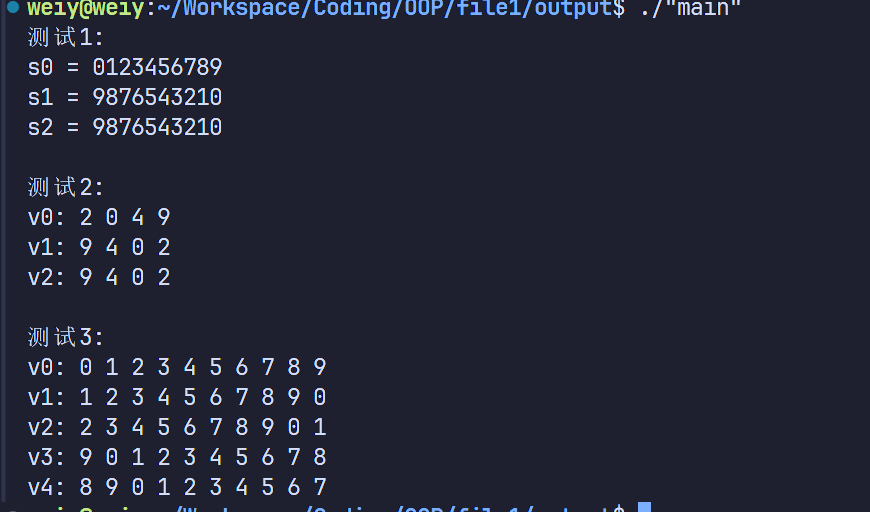
问题 :
- reverse 和 reverse_copy 有什么区别?
答: reverse是把该区间内容反转,reverse_copy是不修改原区间,获取其反转后结果的复制
- rotate 算法是如何改变元素顺序的?它的三个参数分别代表什么?
答: 以中间参数为旋转点,交换左右区间。三个参数代表左边界,旋转点,右边界
实验任务2
task2.cpp:
#include <iostream>
#include <vector>
#include <algorithm>
#include <numeric>
#include <iomanip>
#include <cstdlib>
#include <ctime>
template <typename T>
void output(const T &c);
int generate_random_number();
void test1();
void test2();
int main()
{
std::srand(std::time(0));
std::cout << "测试1: \n";
test1();
std::cout << "\n测试2: \n";
test2();
}
template <typename T>
void output(const T &c)
{
for (auto &i : c)
{
std::cout << i << ' ';
}
std::cout << '\n';
}
int generate_random_number()
{
return std::rand() % 101;
}
void test1()
{
using namespace std;
vector<int> v0(10);
generate(v0.begin(), v0.end(), generate_random_number);
cout << "v0: ";
output(v0);
vector<int> v1{v0};
sort(v1.begin(), v1.end());
cout << "v1: ";
output(v1);
vector<int> v2{v0};
sort(v2.begin() + 1, v2.end() - 1);
cout << "v2: ";
output(v2);
}
void test2()
{
using namespace std;
vector<int> v0(10);
generate(v0.begin(), v0.end(), generate_random_number);
cout << "v0: ";
output(v0);
auto min_iter = min_element(v0.begin(), v0.end());
auto max_iter = max_element(v0.begin(), v0.end());
cout << "最小值: " << *min_iter << endl;
cout << "最大值: " << *max_iter << endl;
auto ans = minmax_element(v0.begin(), v0.end());
cout << "最小值: " << *(ans.first) << endl;
cout << "最大值: " << *(ans.second) << endl;
double avg1 = accumulate(v0.begin(), v0.end(), 0.0) / v0.size();
cout << "均值: " << fixed << setprecision(2) << avg1 << endl;
sort(v0.begin(), v0.end());
double avg2 = accumulate(v0.begin() + 1, v0.end() - 1, 0.0) / (v0.size() - 2);
cout << "去掉最大值、最小值之后,均值: " << avg2 << endl;
}
运行截图:
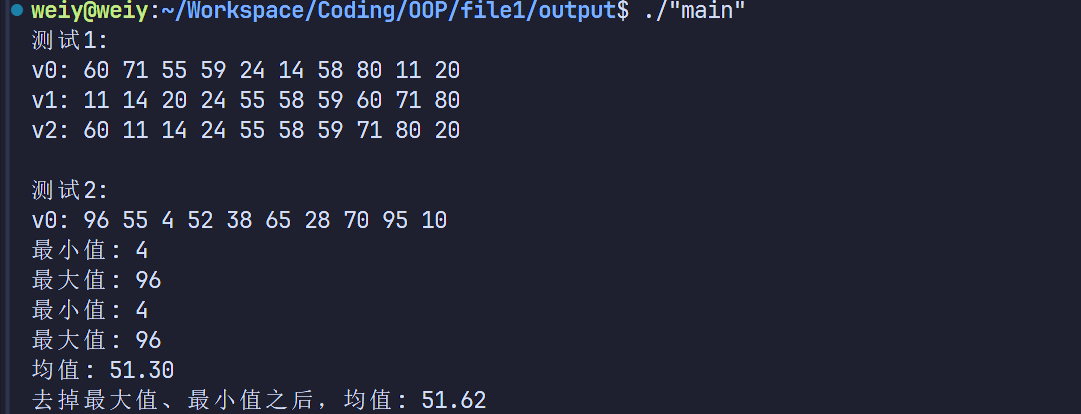
问题:
- generate 算法的作用是什么?
答: 使用第三个参数生成元素来更新前两个参数划分的区间里的元素
- minmax_element 和分别调用min_element 、 max_element 相比,有什么优势?
答: minmax_element只需要一次遍历,性能优
min_element 和 max_element 需要额外遍历一次,分两次调用性能差。
实验任务3:
task3.cpp:
#include <iostream>
#include <string>
#include <algorithm>
#include <cctype>
unsigned char func(unsigned char c);
void test1();
void test2();
int main()
{
std::cout << "测试1: 字符串大小写转换\n";
test1();
std::cout << "\n测试2: 字符变换\n";
test2();
}
unsigned char func(unsigned char c)
{
if (c == 'z')
return 'a';
if (c == 'Z')
return 'A';
if (std::isalpha(c))
return static_cast<unsigned char>(c + 1);
return c;
}
void test1()
{
std::string s1{"Hello World 2049!"};
std::cout << "s1 = " << s1 << '\n';
std::string s2;
for (auto c : s1)
s2 += std::tolower(c);
std::cout << "s2 = " << s2 << '\n';
std::string s3;
for (auto c : s1)
s3 += std::toupper(c);
std::cout << "s3 = " << s3 << '\n';
}
void test2()
{
std::string s1{"I love cosmos!"};
std::cout << "s1 = " << s1 << '\n';
std::string s2(s1.size(), ' ');
std::transform(s1.begin(), s1.end(), s2.begin(), func);
std::cout << "s2 = " << s2 << '\n';
}
运行截图:
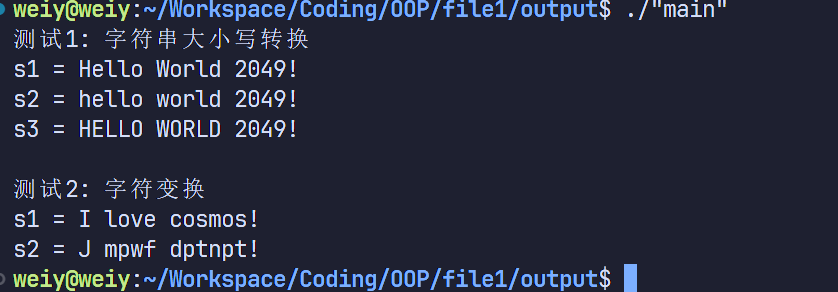
问题:
-
自定义函数func功能是什么?
答: 将26字母作为环,返回输入字符在环上的下一个字符
-
tolower和toupper功能分别是什么?
答: tolower的功能是:将输入字符转换为小写字母。
toupper的功能是:将输入字符转换为大写字母。
-
transform的4个参数分别是什么?如果把第三个参数s2.begin()改成s1.begin(),有何区别
答: transform 的4个参数意义分别是:
第一个参数:输入区间起始迭代器(如 s1.begin())。
第二个参数:输入区间结束迭代器(如 s1.end())。
第三个参数:输出区间起始迭代器(如 s2.begin())。
第四个参数:用于变换的函数(如 func)。
如果把第3个参数 s2.begin() 改成 s1.begin(),区别是:
原来是将变换结果写入 s2(不会影响 s1)。
改成 s1.begin() 后,变换结果会直接替换 s1 原有内容。
实验任务4:
task4.cpp:
#include <iostream>
#include <string>
#include <algorithm>
bool is_palindrome(const std::string &s);
bool is_palindrome_ignore_case(const std::string &s);
int main()
{
using namespace std;
string s;
while (cin >> s)
{
cout << boolalpha
<< "区分大小写: " << is_palindrome(s) << "\n"
<< "不区分大小写: " << is_palindrome_ignore_case(s) << "\n\n";
}
}
bool is_palindrome(const std::string &s) {
size_t midle_len = s.size() / 2;
for(size_t i = 0; i < midle_len; i++) {
if(s[i] != s[s.size() - i - 1]) return false;
}
return true;
}
bool is_palindrome_ignore_case(const std::string &s) {
size_t midle_len = s.size() / 2;
for(size_t i = 0; i < midle_len; i++) {
if (std::tolower(s[i]) != std::tolower(s[s.size() - i - 1]))
{
return false;
}
}
return true;
}
运行截图:
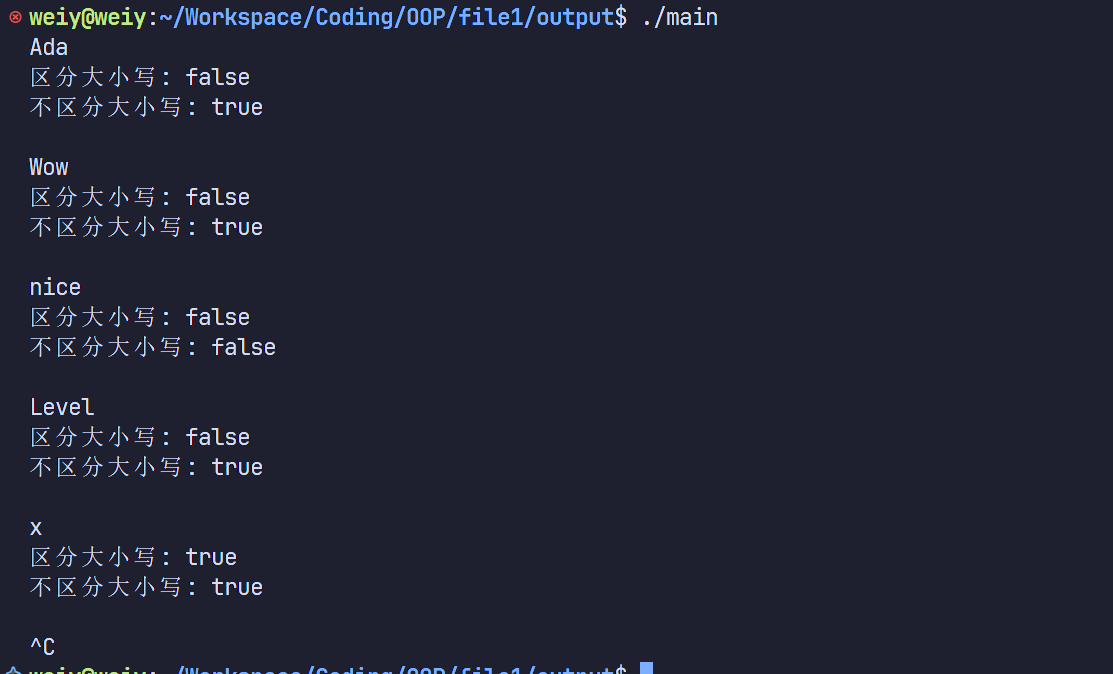
问题:
-
使用 cin >> s输入时,输入的字符串中不能包含空格。如果希望测试字符串包含空格(如 oop ),代码应如何调整?
答 :
将输入方式改为:
std::getline(std::cin, s);
实验任务5:
task5.cpp:
#include <iostream>
#include <string>
#include <algorithm>
const char array[37] = {"0123456789ABCDEFGHIJKLMNOPQRSTUVWXYZ"};
std::string dec2n(int x, int n = 2);
int main()
{
int x;
while (std::cin >> x)
{
std::cout << "十进制: " << x << '\n'
<< "二进制: " << dec2n(x) << '\n'
<< "八进制: " << dec2n(x, 8) << '\n'
<< "十二进制: " << dec2n(x, 12) << '\n'
<< "十六进制: " << dec2n(x, 16) << '\n'
<< "三十二进制: " << dec2n(x, 32) << "\n\n";
}
}
std::string dec2n(int x, int n)
{
if (x == 0)
return "0";
std::string res;
while (x > 0)
{
int r = x % n;
res += array[r];
x /= n;
}
std::reverse(res.begin(), res.end());
return res;
}
运行截图:
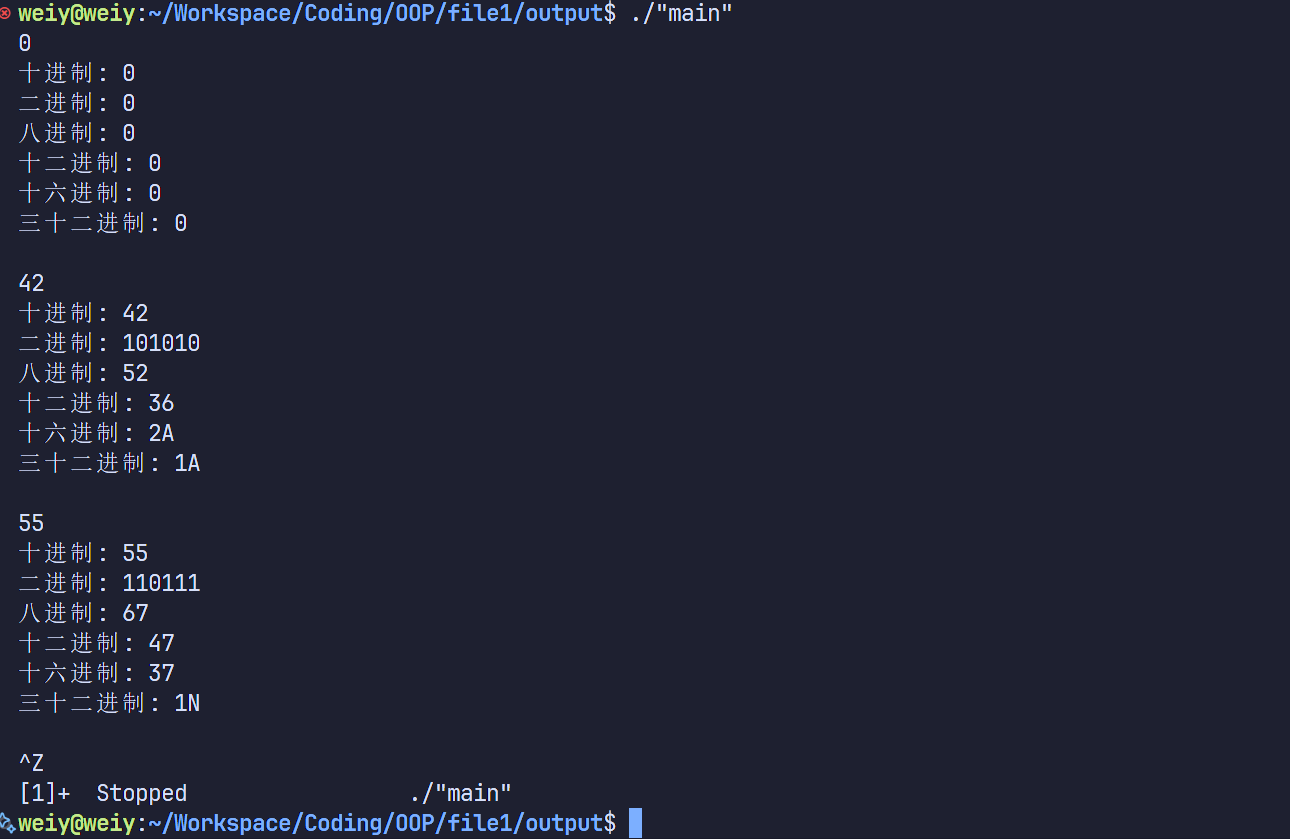
实验任务6:
task6.cpp
#include <iostream>
#include <string>
using namespace std;
string s = "ABCDEFGHIJKLMNOPQRSTUVWXYZ";
int main() {
int l = 1;
cout << " " << " ";
for(auto& c : s) {
cout << (char)(c + 32) << " ";
}
cout << endl;
for(int i = 1; i < 27; i++,l++) {
cout << i << " ";
for(int j = l; j < 26; j++){
cout << s[j] << " ";
}
for(int j = 0; j < l; j++){
cout << s[j] << " ";
}
cout << endl;
}
}
运行截图:
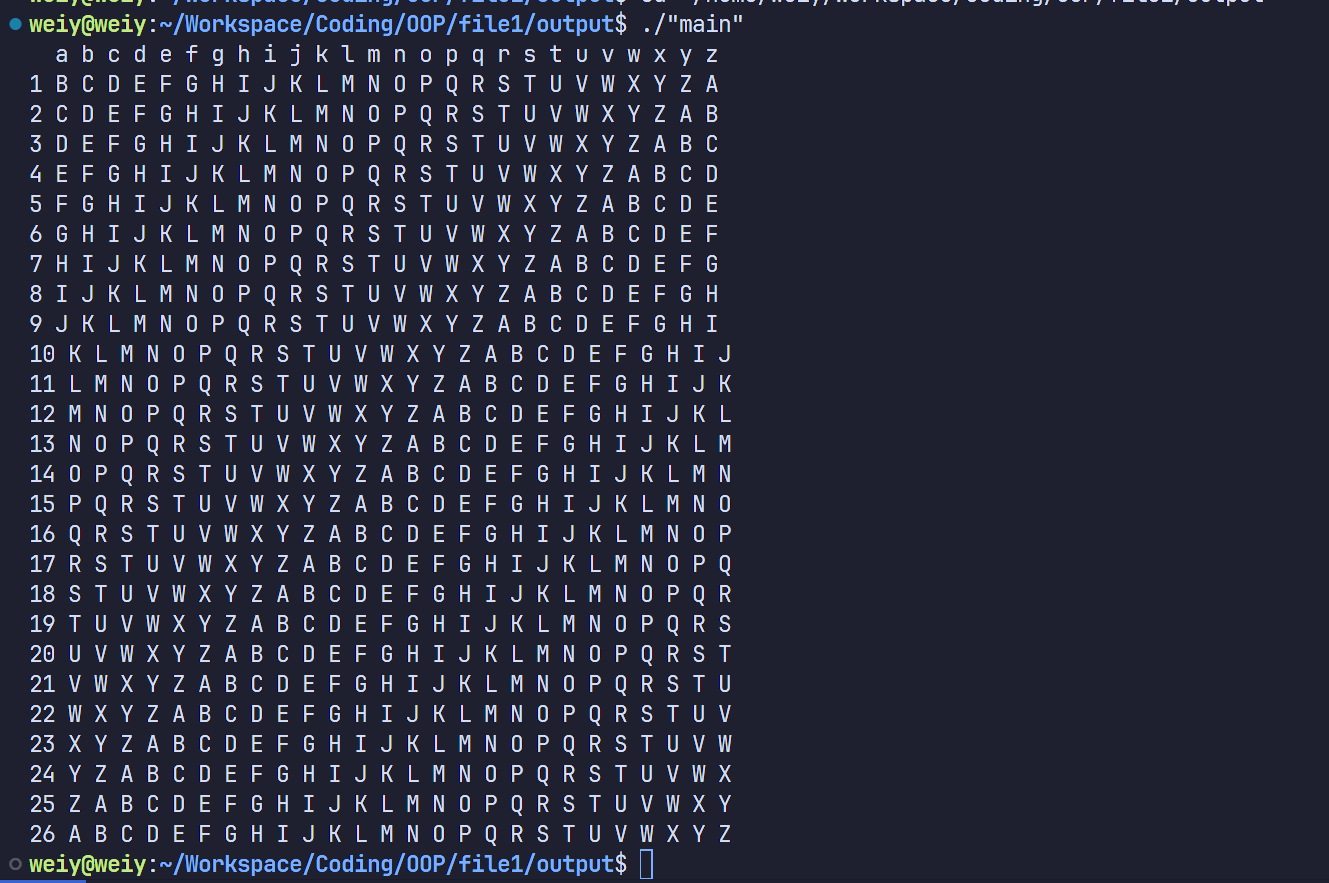
实验任务7:
task7.cpp:
#include <cstdlib>
#include <iostream>
#include <string>
using namespace std;
int main() {
int true_count = 0;
for(int i = 0; i < 10; i++) {
int op = rand() % 4;
int l = 1,r = 2;
int ans = 0;
srand(time(0));
switch(op) {
case 0: {
l = rand() % 10 + 1;
r = rand() % 10 + 1;
cout << l << " " << '+' << " " << r << " " << '=' << " ";
cin >> ans;
if(l + r == ans) true_count++;
break;
}
case 1: {
while(l < r) {
l = rand() % 10 + 1;
r = rand() % 10 + 1;
}
cout << l << " " << '-' << " " << r << " " << '=' << " ";
cin >> ans;
if(l - r == ans) true_count++;
break;
}
case 2: {
l = rand() % 10 + 1;
r = rand() % 10 + 1;
cout << l << " " << '*' << " " << r << " " << '=' << " ";
cin >> ans;
if(l * r == ans) true_count++;
break;
}
case 3: {
while(l % r != 0) {
l = rand() % 10 + 1;
r = rand() % 10 + 1;
}
cout << l << " " << '/' << " " << r << " " << '=' << " ";
cin >> ans;
if(l / r == ans) true_count++;
break;
}
}
}
cout << "正确率: " << true_count * 10 << ".00%" << endl;
}
运行截图:
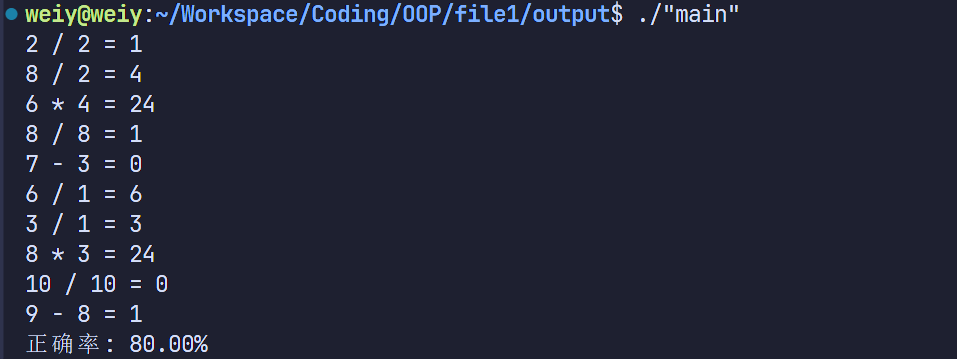


 浙公网安备 33010602011771号
浙公网安备 33010602011771号